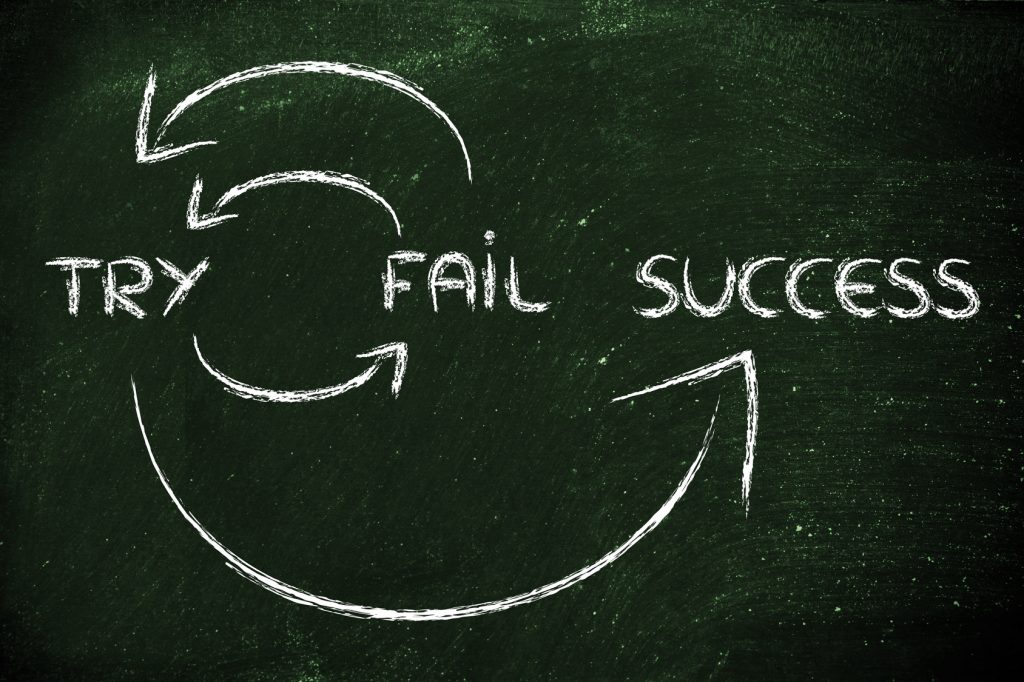Failure: The First of the Steps to Success
Failure. It’s a word that scares most of us out of our wits. It’s an inconceivable word that many are hesitant to experience. To many, failure is not an option.
But, is a fear of failure really healthy? Is failure truly a sign of regression? Is trying and failing worse than not trying at all?
By some societal standards, the answer to those questions is ‘yes’. We’ve become so set on the notion that failure is an unnecessary evil.
We believe that failure is something that consumes us and once it gets us, it doesn’t let go. We believe that failure is embarrassing and makes us less of an individual.
But, most wrongfully, we believe failure is just that- failure to overcome. We don’t see failure for what it truly is- the first steps to success.
Failure Shouldn’t Limit Us
We’re afraid of what our family and friends will think. We don’t think our bosses would approve. We’re terrified of letting the ones around us down.
These are all excuses we give ourselves to keep us from making mistakes. We only remind ourselves of what could go wrong. Instead, we need to consider what could go right.
In many workplace cultures, we feel restrained from looking outside of the box. But, where does staying complacent get us? In the same exact spot.
When we take chances, we may not get where we had hoped to go. But, at least we moved somewhere.
Many will argue that this is better than taking the chance to fall backward. But, is it true?
It’s absolutely not better to stay in the same place. When we’re too afraid of moving anywhere, we limit ourselves in how we can succeed.
We’re not thinking in innovative terms. We’re not thinking of the future. We’re not thinking we can better ourselves.
Complacency is the true failure. When we become so limited in how we live and move and act, that’s when we have failed. But, if we’re still trying, still making mistakes even, we’re on the steps to success.
Taking Personal Steps to Success
Not only should you feel inspired to take risks at your job or in school, but also personally. Your life is an ongoing cycle of challenges and adversaries.
What shapes you is how you let those antagonists effect you. If you run and hide from them, they have won. You have let the fear of failure get to you.
But, when you face these guys head on, you’re starting to get somewhere. Reaching your full potential only comes from looking beyond what went wrong.
Look at what went wrong and move on from it. Embrace failure as a necessary step that is pushing you into the right direction.
Any worthy goal will come with its own set of risks. That holds true from making a career change to starting a new relationship.
But, isn’t the potential reward quite sweet? Is it worth letting your dreams fall by the wayside to avoid these risks that are bound to happen?
Take Amelia Earhart for example. Earhart was the first female pilot to fly over the Atlantic Ocean.
She clearly knew the risks were quite deep. But, when asked why, she simply answered, “Decide whether or not the goal is worth the risks involved. If it is, stop worrying.”
What we should take away from this is to know the weight of our goals. Know the power that they hold over us and whether or not it’ll hurt us to avoid achievement.
If it would affect us? Then, it’s a risk worth taking.
We Learn from Failure
Take another walk down history lane. You’ll notice that more of the biggest contributors to society also made quite a few failures.
Let’s look at the father of electricity, Mr. Thomas Edison. We know he’s the reason behind our modern light sources.
This shouldn’t come as a shock to you, but Edison didn’t come up with the lightbulb overnight. He went through trial and error. And more trial and error. And more trial and error.
In fact, he admitted that it took him over 1,000 tries to perfect what we now know as his masterpiece. He was knocked down 1,000 times and still got back up. But, why?
Because he learned from what went wrong each time. He had the mindset that each wrongful error put him one step closer to cracking the code.
In an interview, Edison had been asked what it felt like to fail over 1,000 times. He responded, “I didn’t fail 1,000 times. The light bulb was an invention with 1,000 steps.”
Shift in Attitude
You may be thinking, “Well, great, that mindset worked for Edison. But, I’m not that positive.”
It’s not easy. It usually doesn’t come naturally. But, a positive attitude is a true make-it or break-it factor when handling failure.
Whether you fail or succeed, there is something to be positive about. Even in instances where you fail, you have taken steps to success in some fashion.
You’ve learned what didn’t work. You’ve learned about your strengths and weaknesses and your ability to form resolutions.
Ascending into this mindset can be tricky for some. So, for those, it’s important to always be conscious of your negative feelings.
Be conscious of how it makes you feel and how it limits you. Be conscious to how you behave and react when it has overcome you. Be conscious of what you’d do otherwise.
Use this as fuel to always practice a positive attitude. Look for the light in situations that feel grim. Again, go back to what you’ve learned and what you’ll do differently next time.
Then, go do it. Don’t be afraid or hold back. Make the necessary adjustments. Do it with the mindset that no matter what happens, you’ve already succeeded.
Final Thoughts
If failure wasn’t one of the steps to success, then we would all avoid it. Everyone would continue to live in a bubble. We would never experience “the next big thing”.
Instead, we live in a society that is constantly pushing the envelope. We’re surrounded by determined, risk-taking individuals. You can be that person, too.
You just have to believe in it.
For more on success, click here.



